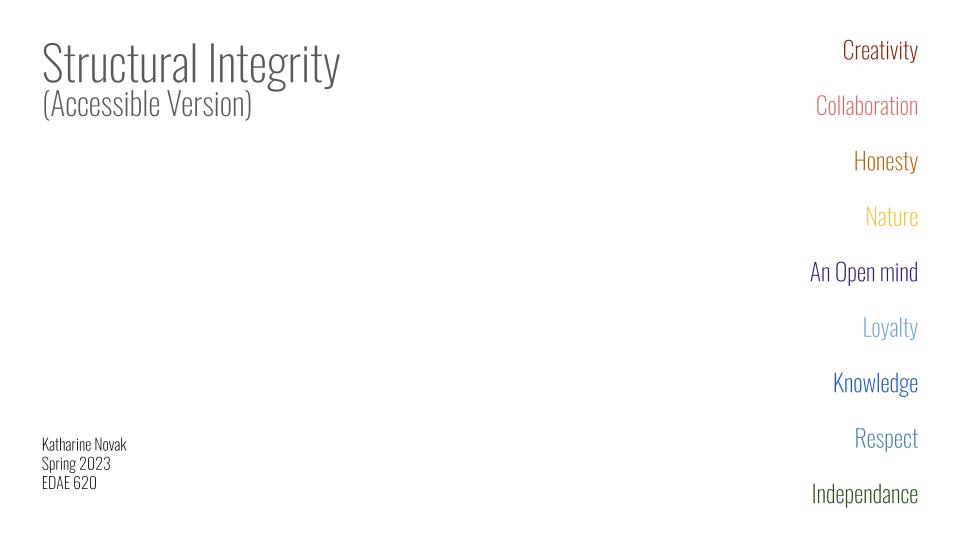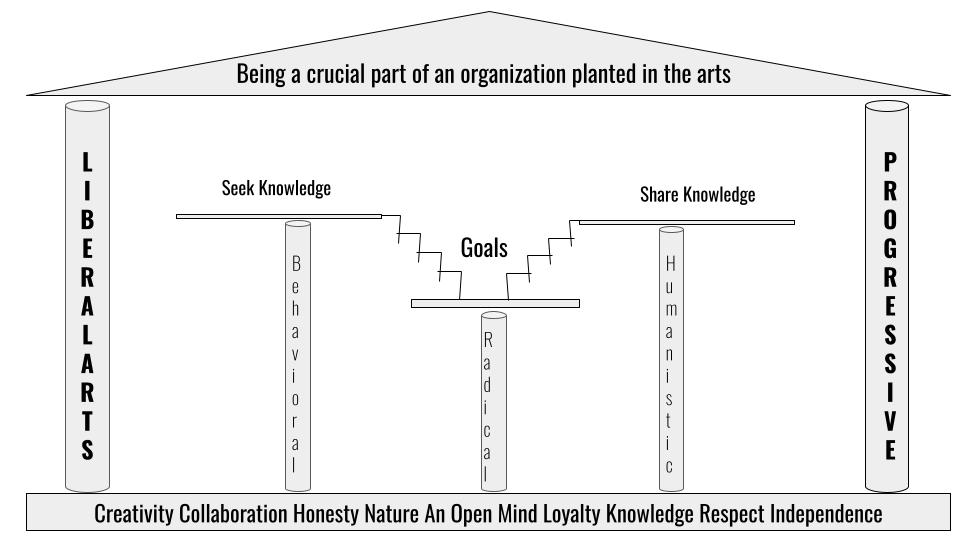
Structural Integrity: My Teaching Philosophy
Katharine Novak
School of Education Colorado State University
EDAE620: Process and Methods
May 5th, 2023
Foundation
By using an architectural metaphor that was inspired by “The Five Pillars” in Enhancing Adult Motivation to Learn, it links my art and design background with my passion for education, both to seek knowledge and share knowledge. However, instead of using the valid pillars from the book; empathy, enthusiasm, clarity, expertise and cultural responsiveness, I am using several principles, tools and styles to create the horizontal and vertical dimensions of my philosophy. The structure is made of my personal values. Some developed long before I knew who Piaget, Bloom or Dewey were and have only honed them since. My values, I believe, have to do with how I was raised (very liberal, open and unsheltered), how I saw the world (and how I see it now), who I want to be and all the obstacles I faced while building my values whether as an ECE teacher or a maker. Here are just a few that directly relate to the reading I have done and how they have shaped how I teach.
Collaboration
I like the simplicity of Hiemstra and Sisco’s 3 R’s rules: (1) Relationships with other class members, many of whom become valuable resources, support givers, and close friends. (2) Relationships with the instructor, built on mutual trust, respect, and credibility. (3) Relationships with the content, material, and resources of the course or workshop. (Hiemstra, R., and Sisco, B. 1990). We are social creatures, whether we like to admit it or not we need one another, to learn from one another, to lean on one another and challenge one another. I believe that regardless of age, position or authority, that equality, respect and trust are fundamental needs to grow. I often facilitate study groups and small discussions with learners to create this trust and respect whether it be focused on a specific topic or learning itself. I have found that in these settings, students and their peers can have open discussions and active participation rather than passively sitting through lectures or long demonstrations. It is important to me that learners lead within their educational path rather than follow, that I am merely a facilitator. I believe that in a group of learners that we are equals and the experiences of those are valid and should be heard. In addition to pertaining to adults, the same holds true for children as well and when I worked with toddlers I was diligent to not speak to them as babies, or use too long a vocabulary.
”All people should be seen this way; not for one thing, or what they are, but ALL the things they are and what they CAN be.” – Me
Honesty
I live by the words, lead by example. In my reading I have found Brookfield’s The Skillful Teacher to align with my views of honesty by emphasizing “the power of role modeling” as one of his six ways of teaching. He starts by stating that “Being explicit about how the teaching and learning experience is to be organized and making sure one’s words and actions as an instructor are consistent and congruent (Brookfield 1990) are an effective practice. I incorporate this ideology by planning and preparing for my time with students, including reaching out to them, ahead of time as much as possible, forming the class as a journey as much for myself as the other participants, and it is important for them to know that early on. Another tenet of Brookfield’s ideology is “being ready to admit errors,” I am a pro at making errors, and admitting to them or that I do not have the answer. This builds on the trust I try to establish in hopes to create a positive experience for the learner. By showing my ability to be honest I hope to promote them to be honest as well, which enables me to better serve them.
Brookfield also believes that instructors should reveal aspects of themselves as a person outside of their role as an instructor (20…) this humanizes instructors and allows learners to be less intimidated and more open within the learning experience. I have found myself to be too honest and have to reset boundaries. I work on this daily, however, I will never stop believing that honesty is the best policy. Lastly, Brookfield ends this statement by saying that we, as facilitators, should take students seriously. By doing so my hope is that they will do the same for me, as well as peers and value an environment that encourages creativity and productivity. It is important to me to try and hold myself to the same standards as I would others; as human.
Knowledge
Another value within my foundation is the exploration for insight. In becoming an educator, I have made a career that allows me to always be learning. I very much learn for the sake of learning. As a long-time student, artist and maker I tend to gravitate to the liberal arts mindset, i.e a well rounded education that focuses more on teaching then being a published professor. On the PAEI Inventory website it characterizes the Liberal philosophy as, “Liberal arts education has been the predominant approach in Western society. The philosophy dates back to the Greeks, where the approach was used to create a population which was intelligent, informed, cultured and moral” (Merriam & Brockett, 1997).” I want to live in a world that learns from history but does not live in its shadow. For humanity to always question, explore and be in the moment but also look into the future. My belief is that by having a well read population that thinks critically, we could achieve this. Characterized also by Zinn, “Liberal arts education primarily revolves around reading books and discussing philosophy, religion, science, literature, the arts and economics.” These ideas immediately felt very near to me when first doing the PAEI. Because students are engaging in the process of reading and discussing their points of view, I have witnessed groups, literally a world apart, learn from each other, share empathy and feel heard. This is why I facilitate study groups and promote small group events. Also, for a more personal reason, by helping learners understand their reasoning for why they are there I am fulfilled by those eager to learn.
Nature
I have known of Malsow’s Hierarchy for some time, in my past life as an Early Childhood Education teacher and in my own therapy. McClusky’s theory of margins seeks balance between the amount of energy needed and the amount available. Using Maslow’s Hierarchy of Needs as an example of this theory, We can not achieve self-esteem, love, belonging and self-actualization without first having food, water, shelter and safety (the lower needs). That is nature. These things play a part in how we learn when we are 5 months old or 55 years old. These needs are essential to my teaching style. I try to ensure that I have a universal learning environment by being prepared for “anything” wherever we are, to the best of my control and am always willing to adapt what I am teaching or the environment for the next class or in a moment’s notice.
Columns
Like books stacked to the ceiling, the columns that rest on my values, my foundations, come from the many books I have read, some may not always be philosophers, but many are. Many were read on my own as a young person and are fiction, sometimes even sci-fi, all the same they impacted my views on the world, my values and often I reflect on them to understand how I am feeling or how to solve a problem. I read Piaget as an ECE student and remembered and reflected on so many of his thoughts on education throughout my career. Bloom, Dewey, Adler and Houle have solidified my views since. When taking the PAEI I was not surprised, but uplifted that I did not fall into one category or belief. I have always been the type to take a little from column A and a little from column B.
Stairs
I see the stairs as being a vertical representation to my goals, as if levels, in the structure of my personal teaching philosophy. These levels are named after the philosophy types taken from the PAEI.
Radial being the first floor,
Humanistic, being the second floor,
Behavioral, being the third floor,
Liberal, being the fourth floor and
Progressive, being the fifth floor.
These literal steps help me name and organize where I want to be as a leader, facilitator, educator or whatever word you prefer to use. Knowing my weaknesses which include needing to create boundaries with students, being a self credited bulldozer and taking on too many projects at once can all be honed by reading, discussing and growing. By always keeping my values close and knowing what elevates my progress I succeed in everyday goals, just as I expect of the adults I guide.
The Ceiling
My main goal, to be a crucial part of an organization planted in the arts, and all others stem from that single idea. Whether it is helping as a stagehand at a puppet show or teaching adults how to create journals out of unwanted materials, or playing with a toddler on the floor and exploring patterning by way of stacking colors I believe everything we do is artful.
References
Brookfield, S. D. The Skillful Teacher. San Francisco: Jossey-Bass, 1990
Hiemstra, R., and Sisco, B. Individualizing Instruction: Making Learning Personal,
Empowering, and Successful. San Francisco: Jossey-Bass, 1990.
Maslow, A. H. (1943). A Theory of Human Motivation. Psychological Review , 50, 370‐396.
Wlodkowski, R. J., & Ginsberg, M.B. (2017). Enhancing adult motivation
to learn: A comprehensive guide for teaching all adults (4th ed.). Jossey Bass.
Zinn, L. M. (1983). PAEI Inventory. LabR Learning Resources. Retrieved
February 2, 2023, from http://www.labr.net/paei/inventory.html

